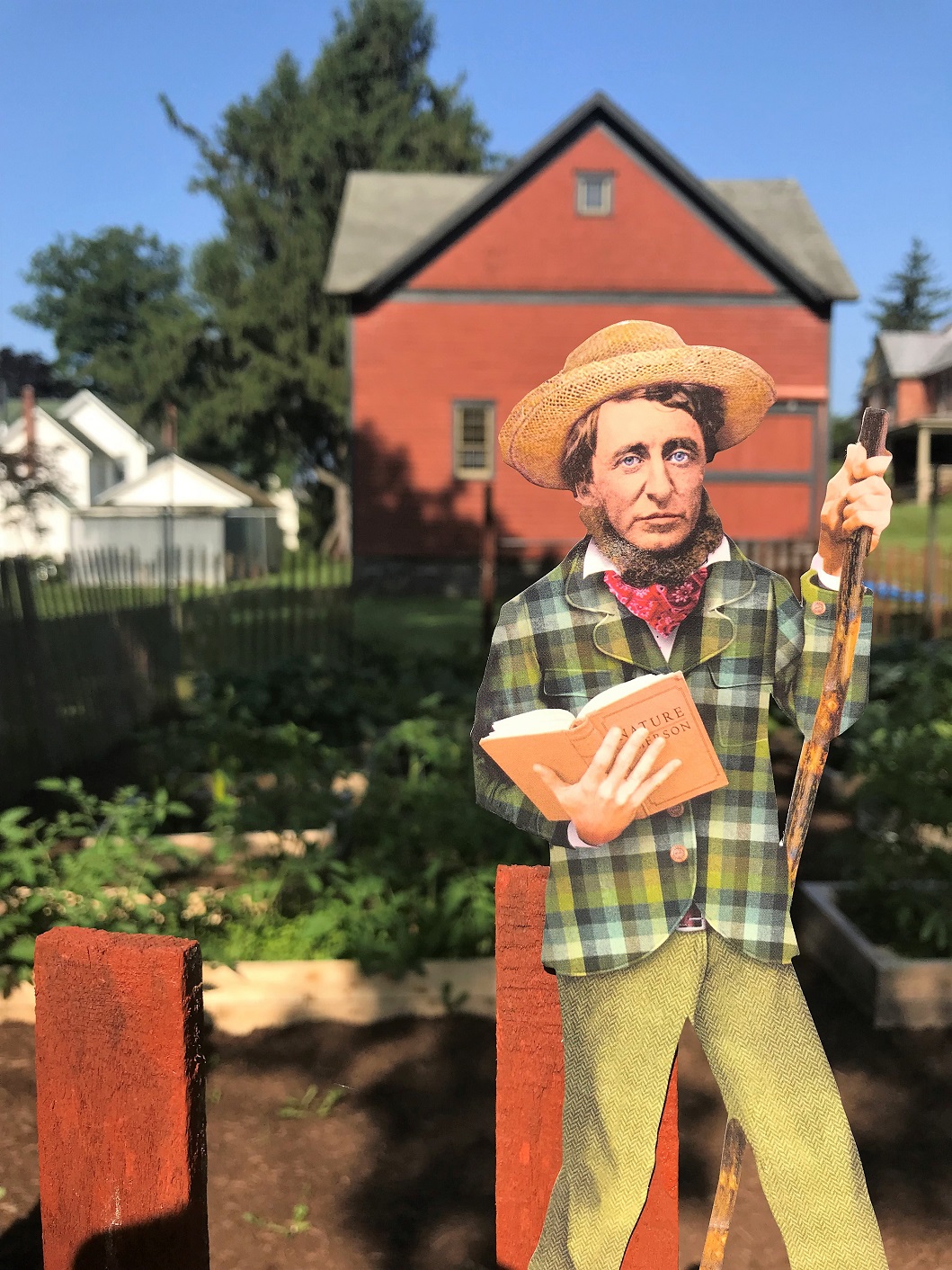Gardening is a strange pleasure. In Walden, Henry David Thoreau describes his experience in the bean field as a “small Herculean labor” and a long battle, the Trojans taking the form of worms, weeds, and woodchucks. For a weapon, he recounts leveling his enemy with his long-handled hoe, turning dirt and dust over the weeds that fought for water and sun with his rows and rows of beans. When reading Thoreau’s story of his bean-field, which I’ve done several times in the past few weeks, it’s almost always this image of Thoreau, fighting against worms, weeds, and woodchucks, that stands out to me. It may have been a battle, but clearly, he enjoyed this “curious labor,” as he describes being out there all summer in the early morning dew, barefoot in the field, until noon, and sometimes, staying there all day to see the evening birds overhead. There’s a certain magnetism in the earth, he says at one point, and I tend to agree.
Like Thoreau, I have my bean field that I’ve planted behind my barn year after year. At times, it seems to be more trouble than worth. The hidden calculus at the back of my mind tells me I must be losing on time and money. Surely, I’d be better off just making a trip to the grocery store, where I’ll ultimately end up buying my lettuce because my stalks in the garden have gone to flower. And yet I continue my little gardening enterprise year after year, knowing, like Thoreau, that there’s something more to be harvested than beans.

Over the life of my garden plot, I’ve tried many things to satisfy that strange pleasure of gardening—far too many to list here. And usually, I take several pictures over the course of the summer, a kind of photographic journal. There’s a picture, for instance, of the garden’s infancy, our first summer at the house, when the farmer up the road brought his tractor down to break ground for us, creating a rather large plot of land. My work even included a scare crow, but the garden proved unmanageable. In another photo several summers later, the garden includes a discarded snow fence I used to keep out the deer that tarry our plants—no woodchucks that nibble our leaves like Thoreau, but rather deer that feast upon them, leaving nothing but bare branches and curses in their wake. Indeed, I’ve never liked the idea of using that green garden fencing, which reminds me of working in a cage, but I found the red vertical slats that comprise snow fencing to be a rather pleasing aesthetic. Then there’s pictures of raised beds some years, large mounds in others. It’s always changing.
This year was no different, as I enlarged the garden dimensions and rearranged to make room for raised beds, which I had done away with only a couple years ago after seeing a friend’s garden. Maybe I’m fickle. This time around I drew inspiration from some pictures from an article in This Old House Magazine, an issue that I’d tucked away for safekeeping because, well, one day I wanted to build a garden like the one featured in that issue, or at least, to build something similar. No, I couldn’t do it exactly the same. So that was my project at the beginning of the summer, using two-by-fours for the beds instead of scrap hardwood flooring, using red as my color palette instead of green, and using brown mulch instead of pea gravel for the paths. And like most of my projects, it’s about 80% finished at this point, but the plants are in the ground and growing. Tomatoes, basil, lettuce, peppers—lots and lots of them in several varieties—potatoes, squash, broccoli, cabbage, brussel sprouts, and cilantro. My tastes are a little more diverse than Thoreau, but my son did throw some beans in a patch of dirt as almost an afterthought, and ironically, it was the only thing that didn’t come up, the seeds having been leftovers from previous years.
The garden is better than last summer, for sure, but there’s always something that could be better. Thoreau gets this, too, for about halfway through his chapter about his beans, he discusses the desire to change things next time, opining that we all too often do the same thing year after year in both our gardens as well as our principles and actions. For Thoreau, change is good, and to me, that’s also one of the strange pleasures of working the soil. Gardening is about returning to the same place day after day, always looking for little ways to improve, to do things differently. I have plants on my property, for instance, that I have moved a half dozen times, hoping to find the best location. Another small flower garden went through a huge transformation a few years ago, as I hauled away a stone border, installed a decorative fence, and carefully placed a few very large rocks. Of course, there were some new plants, too. I’m happier with this garden, too, but I’m always tinkering with improvements.
That’s the difference between gardening and farming. According to Thoreau, the farmer is concerned with the product whereas the gardener is concerned with the process. The gardener realizes there’s more to be gained from working the soil than the harvest and the feast, which brings us back to Thoreau spending so much time hoeing his rows of beans. There are times he relates just standing there, listening to sounds in the distance or watching the nighthawk in the sky above. People stopped by, seeing him there with his beans, to offer advice for a better harvest in the fall, but Thoreau wasn’t farming. In fact, he describes farmers as robbing nature. No, instead, he was gardening. It should be noted, however, that Thoreau preferred the term husbandry when describing his own activities, a term which today seems almost obsolete. For Thoreau, husbandry was a “sacred art,” an activity that connected us to the earth more as stewards rather than owners, cultivating rather than reaping. The word also denotes a kind of management or conservation of resources, too, that anticipates, perhaps, that nature is not an infinite bounty, but something that could slip into a wasteland. Indeed, the land around Walden Pond in the 1840s was not as we see it today, but more desolate, much of it having been timbered and stripped to the ground. The beans were planted, in part, because other crops wouldn’t grow in such poor soil. It’s no wonder then that Thoreau might see himself as husbandman rather than a farmer. And unlike the farmer, the husbandman carries less anxiety, worrying much less about whether he should lose the rewards of his labor. Instead, the labor is the reward, and again, the strange pleasure.
As for me, I’m all right with words like garden, gardening, and gardener. Much better than worms, woodchucks, and weeds, for sure. But it’s that idea of change, I think, that becomes the key to understanding the difference between the gardener and the farmer. For me, gardens are experiments, little places where change is welcome, even encouraged, as the necessary ingredient to the process. It’s a place where possibility dwells, a place where the imagined comes to life. The words maybe next time and what if grow alongside the cabbage and broccoli. That’s what I like about it, and perhaps, that’s what Thoreau loved about it. This past week, on a trip to Creekside Gardens in Tunkhannock, Pennsylvania, that fact was highlighted for me. As my wife and I admired the plants, we struck up a conversation with one of the owners, discussing a miniature garden decorated with fairy houses and little sprites going about their gossamer business. And even as we admired the beautiful little garden, she told us what needed to be changed. “That’s what we’re always doing with our gardens,” she said. I think Thoreau would agree. The pleasure is in the process.

Good article that sums up home gardening very well. Personally, I hate it, but love the end result LOL! My wife loves doing it, as did her mother before her. My dad loved planting his tomatoes and apple trees but they always got out of hand and I’d get stuck with the task of cleaning up most of it (along with doing all the rest of yard work). He worked 6 to 7 days a week so to earn my allowance I got to do the gardening chores. I think that’s one of the reasons that I despise gardening LOL!
LikeLike
I aherd a fantastical conjecture that his beans represented a line seven miles long. Seems a tad rich. Any documented factual accounting of just how many beans he tended?
LikeLike
Nice piece. At least where we are, one gardening year is never the same as another weather-wise, so there’s no such thing as a control experiment. Last year we had a decent crop of courgettes (zucchini, I think you call them) and this year they’re pathetic. First year we’ve tried seriously with beans, funnily enough!
I like the term husbandry.
LikeLike